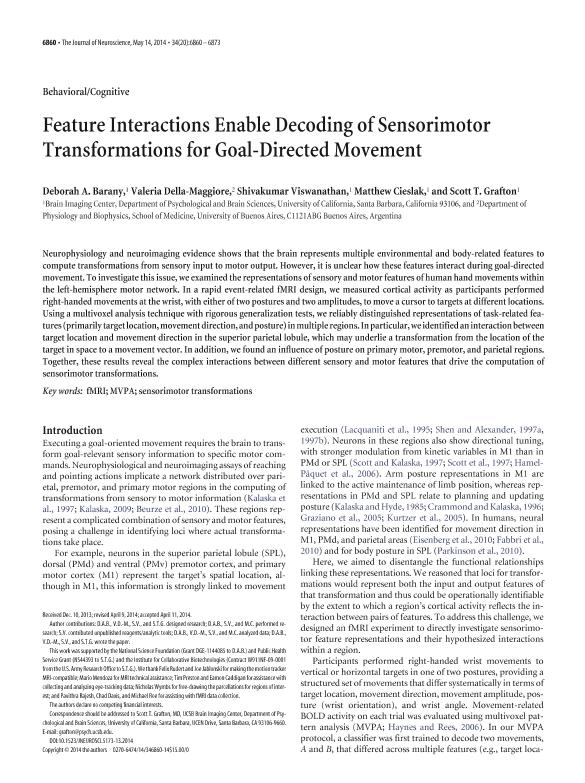Mostrar el registro sencillo del ítem
dc.contributor.author
Barany, D. A.
dc.contributor.author
Della Maggiore, Valeria Monica

dc.contributor.author
Viswanathan, S.
dc.contributor.author
Cieslak, M.
dc.contributor.author
Grafton, Scott T.

dc.date.available
2020-09-10T21:01:22Z
dc.date.issued
2014-05
dc.identifier.citation
Barany, D. A.; Della Maggiore, Valeria Monica; Viswanathan, S.; Cieslak, M.; Grafton, Scott T.; Feature Interactions Enable Decoding of Sensorimotor Transformations for Goal-Directed Movement; Society for Neuroscience; Journal of Neuroscience; 34; 20; 5-2014; 6860-6873
dc.identifier.issn
0270-6474
dc.identifier.uri
http://hdl.handle.net/11336/113755
dc.description.abstract
Neurophysiology and neuroimaging evidence shows that the brain represents multiple environmental and body-related features in order to compute transformations from sensory input to motor output. However, it is unclear how these features interact during goal-directed movement. To investigate this issue, we examined the representations of sensory and motor features of human hand movements within the left-hemisphere motor network. In a rapid event-related fMRI design, we measured cortical activity as participants performed right-handed movements at the wrist, with either of two postures and two amplitudes, to move a cursor to targets at different locations. Using a multi-voxel analysis technique with rigorous generalization tests, we reliably distinguish representations of task-related features (primarily target location, movement direction, and posture) in multiple regions. In particular, we identified an interaction between target location and movement direction in the superior parietal lobule, which may underlie a transformation from the location of the target in space to a movement vector. Additionally, we found an influence of posture on primary motor, premotor, and parietal regions. Together, these results reveal the complex interactions between different sensory and motor features that drive the computation of sensorimotor transformations.
dc.format
application/pdf
dc.language.iso
eng
dc.publisher
Society for Neuroscience

dc.rights
info:eu-repo/semantics/openAccess
dc.rights.uri
https://creativecommons.org/licenses/by-nc-sa/2.5/ar/
dc.subject
Coordinate frames of reference
dc.subject
Motor control
dc.subject
Motor feature interactions
dc.subject
Motor system
dc.subject.classification
Neurociencias

dc.subject.classification
Medicina Básica

dc.subject.classification
CIENCIAS MÉDICAS Y DE LA SALUD

dc.title
Feature Interactions Enable Decoding of Sensorimotor Transformations for Goal-Directed Movement
dc.type
info:eu-repo/semantics/article
dc.type
info:ar-repo/semantics/artículo
dc.type
info:eu-repo/semantics/publishedVersion
dc.date.updated
2020-09-08T13:59:27Z
dc.journal.volume
34
dc.journal.number
20
dc.journal.pagination
6860-6873
dc.journal.pais
Estados Unidos

dc.journal.ciudad
Washington
dc.description.fil
Fil: Barany, D. A.. University of California; Estados Unidos
dc.description.fil
Fil: Della Maggiore, Valeria Monica. Universidad de Buenos Aires. Facultad de Medicina. Departamento de Ciencias Fisiológicas; Argentina. Consejo Nacional de Investigaciones Científicas y Técnicas. Oficina de Coordinación Administrativa Houssay; Argentina
dc.description.fil
Fil: Viswanathan, S.. University of California; Estados Unidos
dc.description.fil
Fil: Cieslak, M.. University of California; Estados Unidos
dc.description.fil
Fil: Grafton, Scott T.. University of California; Estados Unidos
dc.journal.title
Journal of Neuroscience

dc.relation.alternativeid
info:eu-repo/semantics/altIdentifier/url/https://www.jneurosci.org/content/34/20/6860.short
dc.relation.alternativeid
info:eu-repo/semantics/altIdentifier/doi/http://dx.doi.org/10.1523/JNEUROSCI.5173-13.2014
Archivos asociados
